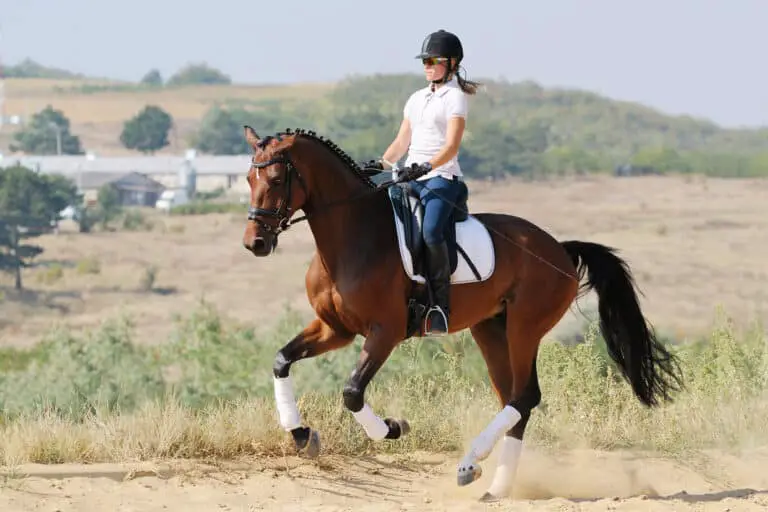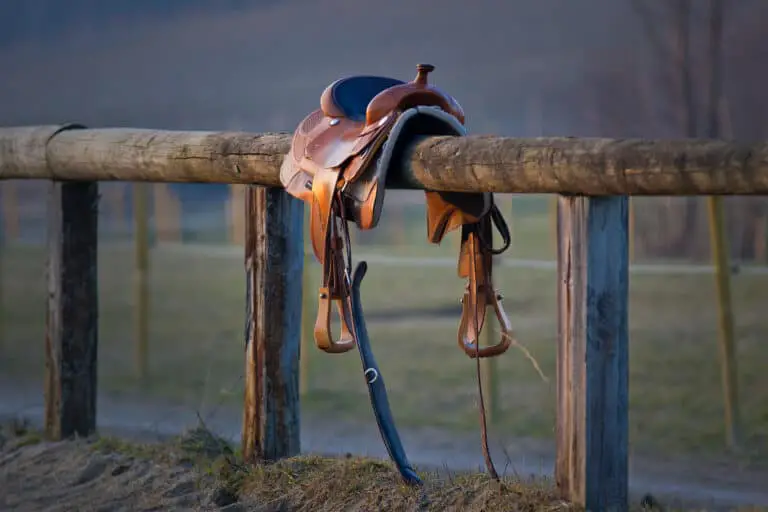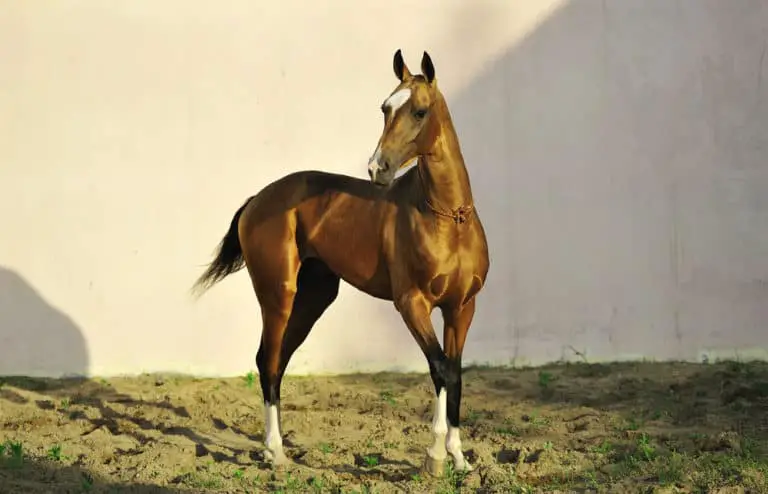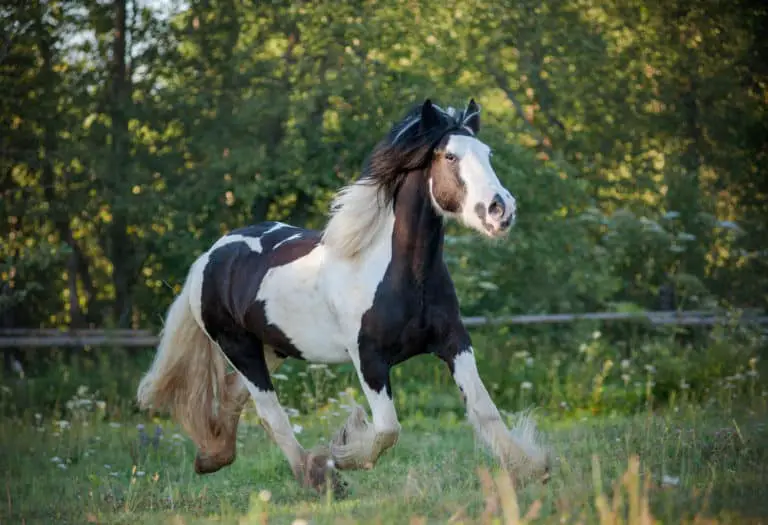Holsteiner Horse Breed: Care, Cost & History (2024)
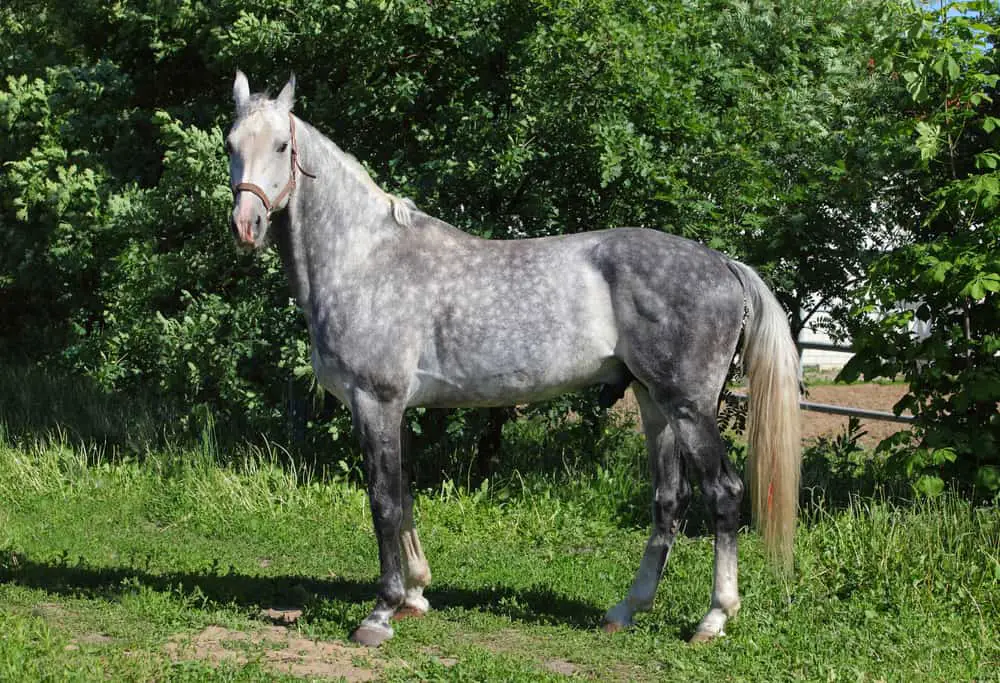
Records indicate that Holsteiner horse breeding has occurred in the Schleswig-Holstein province of northern Germany since the 1200s, making this one of the oldest Warmblood breeds in a country known for high-quality horses. Although they do not have the largest population, their success in the Olympic equestrian sports has made them a beloved and sought-after horse.
Breed: Holsteiner horse
Adult Weight: 1,025 pounds
Adult Height: 16-17 hands (64-68 inches)
Origin: Germany
Use: Sport (dressage, jumping, eventing, and driving)
Colors: Bay, black, dark brown
Features: Large, kind eyes, arched neck, elegant appearance
Lifespan: 20 years
Character: Relaxed, willing workers
Gait: Round, athletic and elastic gaits
Best for: All levels of riders
- Characteristics
- Holsteiner Care
- Holsteiner History
- Modern Holsteiner
- Cost and Ownership
- Buying a Holsteiner
- Similar Breeds
Holsteiner Horse Characteristics
Holsteiner horse characteristics are well-balanced and an elegant breed in appearance and movement. The Holsteiner horse head is considered pretty and has a large, kind eye. They have a long, arched neck that helps create rounded gaits as it connects with a sloping shoulder. The legs are long and straight, and set on strong feet.
Size
Holsteiner size is determined by and regulated by the breed registry. The average Holsteiner horse height is 16 to 17 hands. Horses must be inspected prior to full registration, and a stallion must be a minimum of 16 hands while a mare must be a minimum of 15.2 hands to be fully registered. Foals can begin the preliminary registration process and are eligible for full registration after their inspection. (1)
Warmbloods, including Holsteiner horses, are considered big horses. This is probably one of the reasons why the Holsteiner is an exceptional jumping and sport horse, their long legs and powerful bodies are useful for the high impact disciplines.
Weight
The average Holsteiner horse weight is 1,025 pounds across all adult members of the breed. Males are slightly heavier than females as a rule, but most horses are close to the average weight.
The Holsteiner breed has a strong bone structure because they were originally bred as war horses. It was refined after they were no longer used for war and other types of heavy pulling, but the same strength still exists.
Foals are usually around 100 pounds at birth and then reach their full weight by age six at the latest. However, they do achieve 50% of their adult weight by six months old.
Colors
Holsteiner horse colors are predominantly bay, although the horses can be other colors too, however, bay has long been bred for. Today, the most common colors are bay, black, and dark brown, while chestnuts and grays are also seen regularly.
Rare Holsteiner horse colors are buckskin and palomino, however, even though they aren’t deemed acceptable in the registry, there are some horses registered with these colors. Marlon xx, a Thoroughbred stallion used to improve the breed was dark buckskin and his bloodlines are where rare colors are often found.
The beautiful Holsteiner horse has minimal or no white markings. Horses with coat patterns like paint and leopard spots cannot be registered.
Temperament
The Holsteiner horse temperament is well-regarded for its relaxed demeanor and kind attitude that’s made them popular with riders from the beginning stages to the highest level of the sport. Some members of the breed are steady and patient with new riders, while others are challenging and spirited for riders at the highest levels.
Holsteiner horse behavior is a willing worker that also appears eager. They’re also intelligent horses and easy to train, making an ideal combination of characteristics that are successful in sport horse competition.
The Holsteiner horse uses the general rules of the United States Equestrian Federation and the discipline rules for eventing, combined driving, dressage, and jumping. These rules state that children cannot exhibit stallions. (2)
Holsteiner Horse Care
The Holsteiner horse breed temperament also makes them easy to care for, when compared to other horse breeds. They are generally healthy and low-maintenance horses when their basic standard needs are met. The average Holsteiner horse lifespan is 20 years and they can be active for much of this time and remain healthy.
Diet and Nutrition
The Holsteiner diet requires an adequate intake of water, roughages, and some concentrates that will provide essential vitamins and minerals. The roughages, of which hay and grass are most common, should be at least 50% of the horse’s diet. (3)
The nutritional content of roughages like hay and grass is dependent on their growth stage and the soil where they are grown. Horses in heavy amounts of work, growing horses, and pregnant mares also have different nutritional requirements. Therefore, special attention should be paid to the horse’s life stage and quality of feed. Holsteiners will eat more than other horse breeds in general because they are bigger horses. (3)
Health Problems
Overall, the Holsteiner horse has few health problems. There are a few conditions the breed is more likely to experience though, and some preventative measures that can be taken.
Laminitis can be a problem in the Holsteiner horse when they are worked excessively or because of the extra strain on the hooves from jumping. Owners should avoid working their horses too hard and make sure they get enough rest and recovery. (4)
One of the genetic problems found in Holsteiners is stillbirth in foals, and there is speculation as to whether this has in part contributed to the lower horse population when compared with other horse breeds. Genetic testing to prevent breeding mares with this may be the only solution. (5)
Grooming
Holsteiner grooming is as essential to the horse’s daily care as its diet and nutrition. It’s a good practice for the horse owner because it strengthens the bond with the horse, provides the horse with mental stimulation, and promotes their overall health and wellbeing. (6)
Daily grooming practices should at a minimum include going over the horse’s body to check for injuries or early signs of discomfort and clean the hooves. The hooves are obviously important because they support the entire horse, and small changes in hoof health can have detrimental effects on the horse’s overall useability. (6)
More extensive grooming should be done at least weekly, and before and after the horse is worked. (6)
Holsteiner Horse History
Breeding records, and therefore, Holsteiner horse history, trace back to the thirteenth century in Germany. The first breeding rules and regulations were introduced in 1686, helping to create a uniform breed of the highest quality. These standards have continued as the horses expanded across the globe and evolved with newer breeding practices.
Origin
The Holsteiner horse origin is a rich tapestry of careful breeding and evaluation of quality horses. The Schleswig-Holstein province in Germany, where the Holsteiner horse developed, is the northernmost province in the country. Many breeds of horses originated here, and the Holsteiner is considered one of the older Warmblood breeds.
Foundation breeds used in developing the Holsteiner were the Neapolitan, Oriental horses, and Spanish horses. All of these were crossed with the mares already in the region to create horses for agricultural and military use.
As mechanization meant fewer horses were needed for war and heavy farm work, the breed evolved to serve other roles, again through careful breeding.
Historic Development
In the earliest times, monks were responsible for breeding horses and keeping records, and these date back to the 13th century. They started by breeding for agricultural work and horses that could carry knights. When the military moved to cavalry, the horses became more refined.
Then, farmers and local officials started doing their own horse breeding and further stewarded the breed. The first recorded competition to evaluate stallions against each other was held in 1719.
The Holsteiner Verband, or breed registry, was formed in 1935 when two organizations merged. Finally, in the years following World War II, they used Thoroughbred and French stallions to refine the breed and create the horse we see today.
Notable Holsteiner Horses
Famous Holsteiner horses are an intricate part of the history of northern Germany, as well as modern times. Some were famous for their association with certain people, because of their influence on the Holsteiner horse pedigree, or for amazing athletic feats. History is filled with the names of horses who have left an influential mark on the breed.
The King’s Horses
King Phillip IV of Spain ruled from 1621 until his death in 1665. His foreign policy struggled – he lost the Netherlands and Portugal during his reign, but he did make significant impacts on the arts. He had a strong preference for the Holsteiner and is said to have only ridden the breed at his stud in Cordoba.
Cor de la Bryère
Cor de la Bryère was one of the stallions used to refine the breed after World War II. He was imported from France in 1971 and sired 85 approved stallions for the breed, and 570 mares that went on to be registered. Today, his bloodlines are still found in 80% of all Holsteiner horse pedigrees.
Meteor
Meteor was a Holsteiner gelding that rose to acclaim as a showjumper in the 1950s and 1960s with his rider, Fritz Thiedemann, a German. Together, they captured one bronze and two gold medals at three different Olympic Games (1952, 1956, and 1960). Altogether, they won over 150 competitions and Meteor drew crowds on a similar level as the Beatles.
Myths and Legends
Many of the Holsteiner horse legends surround their breeding program and the way it is established. One aspect that has kept their breeding legendary is the strict adherence to a geography-based program. The breed remains centered in Germany, and exports are the primary means of finding Holsteiner horses in other countries.
The C & L Families
A Holsteiner foal that is a colt must have a name that starts with the first letter of his sire’s name. We see many Holsteiner horses with names that begin with a C or an L. Cor de la Bryère is part of the C families, and the L families stem from Ladykiller xx, an influential Thoroughbred stallion.
The Mare Lines
The Holsteiner breed organizations began inspections for breed registration in 1885, and from the beginning, the mare lines have been important to the breed. The Holsteiner Verband developed a separate evaluation system for mares in the 1980s including their own conformation and performance standards. Approximately 400 mares go through the system each year in Germany.
Universal Stallions
The Holsteiner stallion and their bloodlines are respected and valued by other warmblood breeders. They use Holsteiners in their jumping and dressage programs to improve and create better horses. Many Olympic and high-level horses have a Holsteiner parent of heritage, including Calecto, a horse on the United States Olympic dressage team, who has a Holsteiner sire.
Modern Holsteiner Horses
The types of Holsteiner horses we see today are different looking than those painted with King Phillip IV of Spain. They are more refined, elegant, and athletic, in part because of their purpose. Today’s horses are bred to be performance horses in dressage, jumping, and other disciplines, where they dominate as top performers.
Breeding
Holsteiner breeding is still centered in the Schleswig-Holstein region of Germany and throughout the rest of the country as well. However, the breeders have long exported horses to other countries as part of their breeding plan. In fact, in the year 1797, they exported over 10,000 horses. Exports have continued with the different types of horses we see today.
This means that Holsteiner horses breeding is concentrated in Germany, but the horses are found worldwide. Naturally, the bloodlines tracing back to the C and L families are popular, as well as those of other stallions. Most breeding focuses on producing sport horses for the jumping, dressage, eventing, and combined driving disciplines.
Population
The Holsteiner horse population is only 6% of Europe’s total horse population, or around 270,000 horses total. There are around 5,000 registered (7) This number specifies purebred Holsteiners, and it’s important to remember that stallions are used in many other breeds too. There are about 5,500 registered mares in Germany.
The United States and Australia also have Holsteiner breed associations, however, most of the breeding is still done in Germany, and horses are exported to other countries. The Holsteiner Verband doesn’t support shipping frozen semen, and this has helped keep horse sales in Germany strong and the export business thriving.
Uses
The Holsteiner horse uses are focused on the Olympic and sport disciplines, as well as breeding stock. Different bloodlines have introduced genetic traits that have made the Holsteiner horse superior as a jumper and in other sport disciplines, and sought after.
The Holsteiner horse gait is driven by a powerful hind end. The movement is round and elastic, creating an elegant image with their arched neck and body type. Holsteiner horses have a lot of impulsion and joint articulation – or the flexion at the knees and hocks – which adds to their lovely gaits. Many riders say the canter is their best and most comfortable gait.
Holsteiner Horse Prices
Owning a horse fulfills a lifelong dream for many people, and all dreams have their associated costs. The Holsteiner horse price is higher than most people realize because, in addition to buying the horse, it also requires daily care. The expenses are the equivalent of our mortgage or rent, grocery, and utility bills.
Purchase Price
The purchase price of Holsteiner horse is the first one you will encounter. This is between $10,000 and $30,000, however, a horse with the best bloodlines or Olympic level potential will obviously cost more than this. (8)
Horses with the bloodlines of Olympic athletes, especially following an Olympic or World Cup event, will cost considerably more.
The level of Holsteiner horse training is another factor that sometimes influences purchase price. A young horse that’s untrained will be on the lower level of the price range, whereas a fully trained horse ready to be ridden and compete will cost more. The age of a horse at the time of purchase can also influence its price.
Ownership Costs
The Holsteiner horse cost of ownership is between $1,770 to $12,930 per year. This includes the board or place where the horse lives, feed, veterinary care, and hoof care. All of these are essential and must be calculated into the Holsteiner price, along with the initial purchase price.
Board
Board is home for your Holsteiner horse, it’s a stall in a stable with access to a pasture, or a run-in shed in a field. Board prices vary based on the amenities, if you do any of the horse care, and the geographic location. Holsteiner horse board cost will be between $1,200 and $7,200 per year. (9)
Feed
Everyone enjoys eating, and the Holsteiner horse does too. The feed provides the energy the horse needs to survive. Feed costs will again vary depending on the amount of grass available and how much work the horse is doing. Price ranges for Holsteiner horse feed cost are $250 to $4,380 per year. (9)
Veterinary Care
Basic veterinary care is essential for health and well-being in horses, just like medical care is for humans. The Holsteiner horse veterinary cost is $250 to $350 each year for vaccines, dewormer, and dental care. IIf the horse gets injured, there will be an added expense, and it can cost up to $1,000 per injury. (9)
Hoof Care
Holsteiner horse hoof care cost is another aspect of ownership to budget for. Hooves grow the way our fingernails do – non-stop. Trained farriers trim the hooves to keep them balanced and healthy every six to eight weeks. Horseshoes will increase the price. The cost is $120 to $1,000 each year. (9)
Buying a Holsteiner Horse
Buying a horse is an exciting journey, but just like you don’t head out on a road trip without planning your route, it’s important to spend some time planning to buy a horse from the Holsteiner breed. The personalities and athletic abilities of each horse are unique, so it’s important to know what you want and meet several horses.
Is the Holsteiner Horse Right for You?
The Holsteiner horse is right for you if you enjoy jumping, combined driving, eventing, or dressage – or want to learn one of these disciplines. Owning a Holsteiner horse can help make your riding dreams come true because they are so naturally talented in these disciplines and thoroughly enjoy the work.
People of all levels enjoy riding a Holsteiner horse because there are so many personality types within the breed, those that are good for new riders and those that will challenge an Olympian. Their gaits are springy and make you feel like you’re walking on clouds, adding to the sheer joy of the experience.
How to Buy a Holsteiner Horse?
Buying a Holsteiner horse can be a longer process than with other breeds because most are still bred in Germany. However, there are equestrian professionals that help riders import horses every day. In the United States and Australia, there are Holsteiner horse populations to choose from too.
Prospective buyers should contact a Holsteiner breeder to learn more about the horses, bloodlines, and which horses are best for the goals the rider has. The breeder can help identify other breeders and equestrian import agents.
Identify several horses to look at and test. Ask to see the horse work and to ride or drive it yourself. A veterinarian should conduct a pre-purchase exam as the final step.
Similar Breeds to Holsteiner
Germany is the epi-center of sport horse breeding, with many incredible horse breeds developing there.
A few Holsteiner breed alternatives include two breeds from Germany and one from Prussia, the Hanoverian, Oldenburg, and Trakehner, respectively.
All four breeds excel in dressage, jumping, and eventing. The Hanoverian and Trakehner breeds had Thoroughbred influences, like the Holsteiner.
Hanoverian
The Hanoverian horse is another Warmblood breed from Germany. They are also incredibly popular in the sport disciplines and Hanoverians have won Olympic gold medals in dressage, show jumping, and eventing. They are beautiful and athletic horses with good temperaments. Hanoverians were developed using Holsteiner stallions as the founding sires.
Oldenburg
Oldenburg horses are another German sport horse breed, although this breed was developed using a strict mare line, versus an emphasis on stallion lines. Oldenburgs are tall horses that were originally bred to pull carriages. They are quite successful in dressage and jumping. Today, they have one of the larger warmblood breed registries in Germany.
Trakehner
The Trakehner is another warmblood breed, and they are considered the lightest and most refined of all warmbloods. The breed developed in the Trakehnen region of Prussia (which was annexed by Russia) and also traces some of its bloodlines to Thoroughbred founders. The triangular body shape of the Trakehner horse makes the breed easily recognizable.
FAQ
What is a Holsteiner horse?
A Holsteiner horse is an athletic warmblood sport horse with elegant gaits. They are kind horses popular with riders at all levels.
What does a Holsteiner horse look like?
Holsteiner horses are tall, well-balanced horses. Most are dark colors like bay, black, and dark brown with little or no white markings.
How did the Holsteiner horse get its name?
The Holsteiner horse is named for the Schleswig-Holstein province in northern Germany where they originated.
Can you ride a Holsteiner horse?
Yes, the Holsteiner horse is a great riding horse and one of the top breeds in the Olympic equestrian disciplines.
Are Holsteiner horses good for beginners?
Some Holsteiner horses are excellent for beginners as they have a relaxed temperament, but it will depend on the individual horse.
How tall is a Holsteiner horse?
A Holsteiner horse is between 16 and 17 hands, or 64 to 68 inches tall at the withers.
How much does a Holsteiner horse weigh?
The average Holsteiner horse weighs 1,025 pounds.
How big is a Holsteiner horse?
The Holsteiner horse is a fairly large horse, although not the biggest of breeds. Their arched neck makes them appear bigger.
How much does a Holsteiner horse cost?
A Holsteiner horse can cost anywhere from $10,000 to $30,000 with horses that have Olympic-level potential costing even more.
How much does Holsteiner horse ownership cost?
Holsteiner horse ownership will cost between $1,770 to $12,930 per year.
How long do Holsteiner horses live?
Holsteiner horses live for about 20 years.
How fast can a Holsteiner horse run?
A Holsteiner can run between 25 and 30 miles per hour.
How much can a Holsteiner horse pull?
A Holsteiner horse can pull approximately 1,538 pounds.
How much can a Holsteiner horse carry?
Holsteiner horses can carry up to 205 pounds.
At what age is a Holsteiner horse full grown?
A Holsteiner horse is full-grown between the ages of four and six.
What are Holsteiner horses used for?
Holsteiner horses are used for sport disciplines including dressage, jumping, eventing, and driving; they consistently perform well at the Olympics.
References
- Holsteiner Verband. 2020.Satzung des Verbandes der Züchter des Holsteiner Pferdes e. V. Link
- United States Equestrian Federation. 2022. Licensed Competitions. Link
- Merck Vet Manual. 2021. Nutritional Requirements of Horses and Other Equids. Link
- Yasuyuki Usami, ECFVG. 2004. Equine Acute Laminitis. Link
- Institute of Animal Breeding and Husbandry at the Christian Albrechts University in Kiel. 2014. Reproduction and health in Holstein Warmblood mares – Impact of population structure and data recording. Link
- Merck Vet Manual. 2011. Routine Health Care of Horses. Link
- Holsteiner Verband North American Breeding District. 2022. The Holsteiner Horse. Link
- Ehorses. 2022. Holsteiner Horse Prices. Link
- Arabian Horse Association. 2022. What is the Cost of Providing for Them? Link

